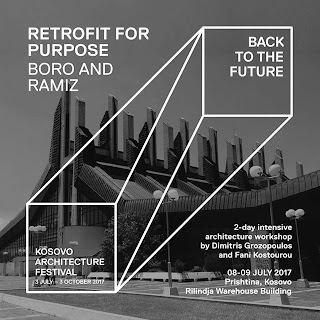#Workshop title: Retrofit for Purpose – Boro and Ramiz - Kosovo Architecture Festival
#students: H.Kollari, K.Ymeri, D.Kolgeci, R.Pafe, S.Stephenson
#supervisors: D.Grozopoulos, F.Kostourou
#date: July 2017
Workshop title: Retrofit for Purpose – Boro and Ramiz
Leaders: Dimitris Groz and Fani Kostourou
Students: H.Kollari, K.Ymeri, D.Kolgeci, R.Pafe, S.Stephenson
Dates: July 08 – July 09 2017
Event page: events fb page
Workshops description
According to David Kincaid,
the most sustainable built forms are those well-designed buildings which have
such an aesthetic quality that people prefer to adapt their activities to fit
them rather than change them either slightly or extensively. Stewart Brand calls
these buildings ‘high-road’, referring to buildings of permanence, high intent
and aesthetic value as well as long-lasting sustained purpose. He argues that high-road
buildings are always being noticed, looked after and preserved in successive
refinements. The only actual threat of high-road buildings over time is the shifting
real-estate market and/or sudden disasters. Otherwise, the buildings grow “by
stages with constant minute refinement and breezy innovation comfortably
expressed by the attentive intelligences coevolving with the building” and “the
result is human: a building by the people, for the people and of the people
within.”
This is the case with the Palace
of Youth and Sports also known as Boro and Ramiz in the city of Prishtina, in
Kosovo. It was built in 1977 by the architect Živorad Jankovic, as a symbol of
brotherhood and unity between Serbs and Albanians who constituted the majority
of the population in Kosovo. The complex consisted of two arenas, a shopping
mall, a library, two convention centres and an indoor parking. The main
building sheltering the two large arenas, was developed as an asymmetric
structure with a central core serving as a main access to the complex. In 2000,
the palace was heavily damaged in a fire. Since then and despite its partial
renovation, the large arena and convention hall have been abandoned. Yet the
lesser area has been used by the Sigal Prishtina basketball club, but has also
hosted other sports events,
various concerts, exhibitions, fairs, conventions, and congresses.
During the first stage and prior to the workshop, a social media
discussion platform for crowdsourcing ideas was established from interested parties. Local groups and individuals
interested to be part of the discussion about the future of Boro and Ramiz had the opportunity to
express their views and debate other people’s suggestions.
In the second stage, the workshop
participants were invited to respond, develop further and ‘render’ some of the crowdsourced
ideas. Through visual representations, line drawings and physical models, the
participants explored a series of already generated ideas regarding how to
activate Boro and Ramiz. The
objective of both the crowdsourcing and the workshop outcome is to propose a new dynamic
urban node on the site of Boro and Ramiz and ensure that a building of such architectural
and cultural value will remain fit not
only for its purpose as a mixed-use development and symbol of societal unity, but
also for the people and the city.
The two main ideas that have been chosen and developed through the workshop were
Botanical gardens and Innovation and start-up centre.
Botanical gardens and urban agriculture spaces
Boro and Ramiz could be transformed into the biggest green house of the city. Botanical gardens and community farms along with natural play spaces dotted throughout the building could enable all ages to let off steam. A natural trail at the heart of the city inside one of the most iconic buildings invites young explorers to discover the secret life of trees and plants through interactive adventures.
Innovation and start-up centre
Kosovo could attract large foreign-owned corporations with special privileges and also support smaller business ventures of a domestic and international nature. The building of Boro and Ramiz in Pristina could act as a catalyst to regenerate the city and local community. A new start-up ecosystem could start to take shape through the creation of incubators and seed-financing schemes helping both the locals and the economy to grow.
The two main ideas that have been chosen and developed through the workshop were
Botanical gardens and Innovation and start-up centre.
Botanical gardens and urban agriculture spaces
Boro and Ramiz could be transformed into the biggest green house of the city. Botanical gardens and community farms along with natural play spaces dotted throughout the building could enable all ages to let off steam. A natural trail at the heart of the city inside one of the most iconic buildings invites young explorers to discover the secret life of trees and plants through interactive adventures.
Innovation and start-up centre
Kosovo could attract large foreign-owned corporations with special privileges and also support smaller business ventures of a domestic and international nature. The building of Boro and Ramiz in Pristina could act as a catalyst to regenerate the city and local community. A new start-up ecosystem could start to take shape through the creation of incubators and seed-financing schemes helping both the locals and the economy to grow.













No comments :
Post a Comment